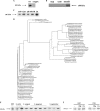Deletion of a cation transporter promotes lysis in Streptococcus pneumoniae
- PMID: 21422174
- PMCID: PMC3125841
- DOI: 10.1128/IAI.00677-10
Deletion of a cation transporter promotes lysis in Streptococcus pneumoniae
Abstract
Streptococcus pneumoniae is a significant human pathogen which causes respiratory and serious invasive diseases. Mg(2+) is essential for life, and its concentration varies throughout the human body. Magnesium uptake plays an important role in the virulence of many bacterial pathogens. To study the Mg(2+) uptake of S. pneumoniae strain D39, a mutant was generated in SPD1383, a P-type ATPase with homology to the Salmonella Mg(2+) transporter MgtA, which has also been shown to be a Ca(2+) exporter in strain TIGR4. Under low-Ca(2+) conditions, mutation led to a growth defect in complex medium and the gene was nearly essential for growth under low-Mg(2+) conditions. Addition of Mg(2+) restored the normal growth of the mutant in all cases, but the addition of other divalent cations had no effect. Addition of Ca(2+), Mn(2+), and Zn(2+) in the presence of high Mg(2+) concentrations inhibited restoration of growth. The mutant was unable to proliferate in blood, which was also alleviated by the addition of Mg(2+). The protein was located in the membrane and produced in various S. pneumoniae strains and pathogenic streptococcal species. Surprisingly, mutation of the gene led to an elevated toxicity for endothelial cells. This was caused by an increased amount of pneumolysin in the medium, mediated by elevated lysis of the mutant. Thus, in this study, we uncovered a role for SPD1383 in Mg(2+) uptake and hypothesize that the protein is a Mg(2+/)Ca(2+) antiporter. Furthermore, a disturbance in Mg(2+) homeostasis seems to promote lysis of S. pneumoniae.
Figures




Similar articles
-
Global transcriptional analysis of clpP mutations of type 2 Streptococcus pneumoniae and their effects on physiology and virulence.J Bacteriol. 2002 Jul;184(13):3508-20. doi: 10.1128/JB.184.13.3508-3520.2002. J Bacteriol. 2002. PMID: 12057945 Free PMC article.
-
The Opp (AmiACDEF) Oligopeptide Transporter Mediates Resistance of Serotype 2 Streptococcus pneumoniae D39 to Killing by Chemokine CXCL10 and Other Antimicrobial Peptides.J Bacteriol. 2018 May 9;200(11):e00745-17. doi: 10.1128/JB.00745-17. Print 2018 Jun 1. J Bacteriol. 2018. PMID: 29581408 Free PMC article.
-
Competence and virulence of Streptococcus pneumoniae: Adc and PsaA mutants exhibit a requirement for Zn and Mn resulting from inactivation of putative ABC metal permeases.Mol Microbiol. 1997 Aug;25(4):727-39. doi: 10.1046/j.1365-2958.1997.5111879.x. Mol Microbiol. 1997. PMID: 9379902
-
Microbial magnesium transport: unusual transporters searching for identity.Mol Microbiol. 1998 Apr;28(2):217-26. doi: 10.1046/j.1365-2958.1998.00810.x. Mol Microbiol. 1998. PMID: 9622348 Review.
-
MgtA and MgtB: prokaryotic P-type ATPases that mediate Mg2+ influx.J Bioenerg Biomembr. 1992 Jun;24(3):319-28. doi: 10.1007/BF00768852. J Bioenerg Biomembr. 1992. PMID: 1328179 Review.
Cited by
-
The N-Acetylglucosaminidase LytB of Streptococcus pneumoniae Is Involved in the Structure and Formation of Biofilms.Appl Environ Microbiol. 2020 May 5;86(10):e00280-20. doi: 10.1128/AEM.00280-20. Print 2020 May 5. Appl Environ Microbiol. 2020. PMID: 32198170 Free PMC article.
-
Physiology, Genomics, and Pathway Engineering of an Ethanol-Tolerant Strain of Clostridium phytofermentans.Appl Environ Microbiol. 2015 Aug 15;81(16):5440-8. doi: 10.1128/AEM.00619-15. Epub 2015 Jun 5. Appl Environ Microbiol. 2015. PMID: 26048945 Free PMC article.
-
Pneumococcal gene complex involved in resistance to extracellular oxidative stress.Infect Immun. 2012 Mar;80(3):1037-49. doi: 10.1128/IAI.05563-11. Epub 2012 Jan 3. Infect Immun. 2012. PMID: 22215735 Free PMC article.
-
Pyruvate oxidase influences the sugar utilization pattern and capsule production in Streptococcus pneumoniae.PLoS One. 2013 Jul 3;8(7):e68277. doi: 10.1371/journal.pone.0068277. Print 2013. PLoS One. 2013. PMID: 23844180 Free PMC article.
-
Spermidine biosynthesis and transport modulate pneumococcal autolysis.J Bacteriol. 2014 Oct;196(20):3556-61. doi: 10.1128/JB.01981-14. Epub 2014 Aug 4. J Bacteriol. 2014. PMID: 25092031 Free PMC article.
References
-
- Reference deleted.
Publication types
MeSH terms
Substances
Associated data
- Actions
LinkOut - more resources
Full Text Sources
Other Literature Sources
Molecular Biology Databases
Miscellaneous

